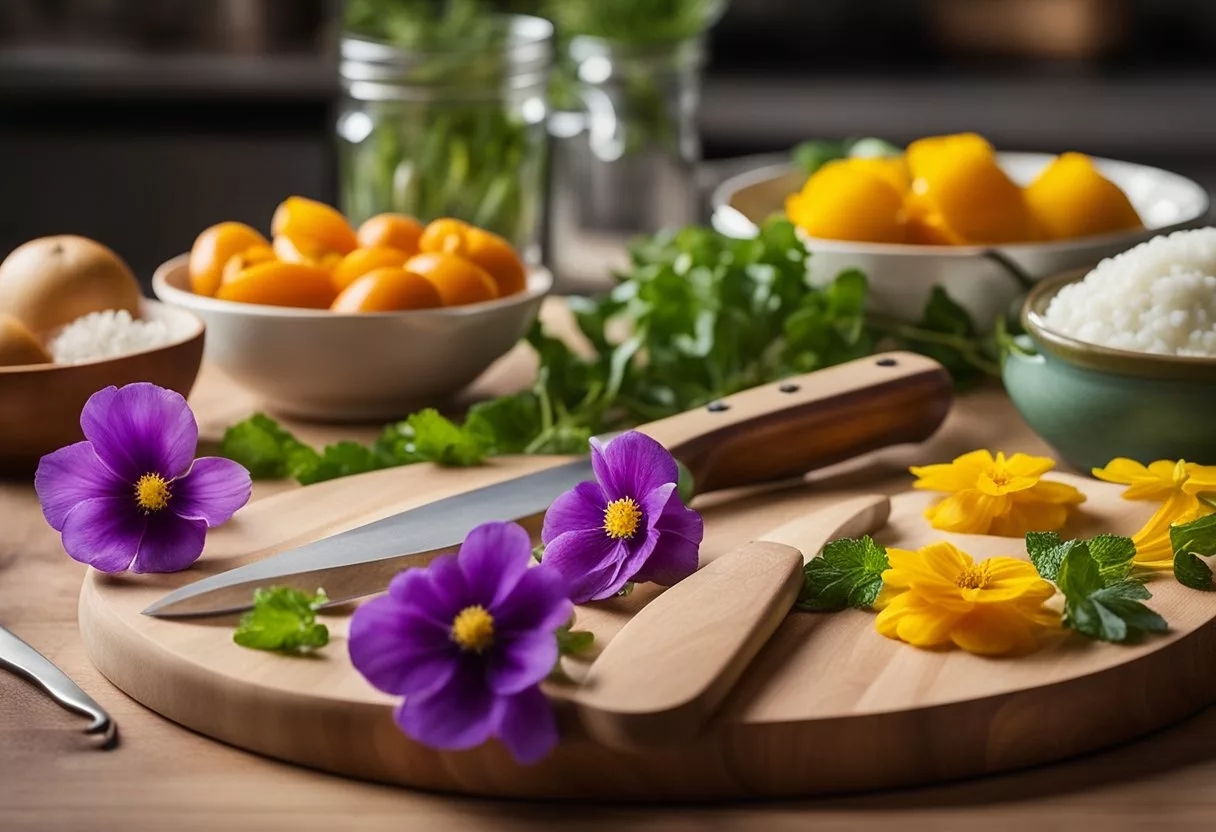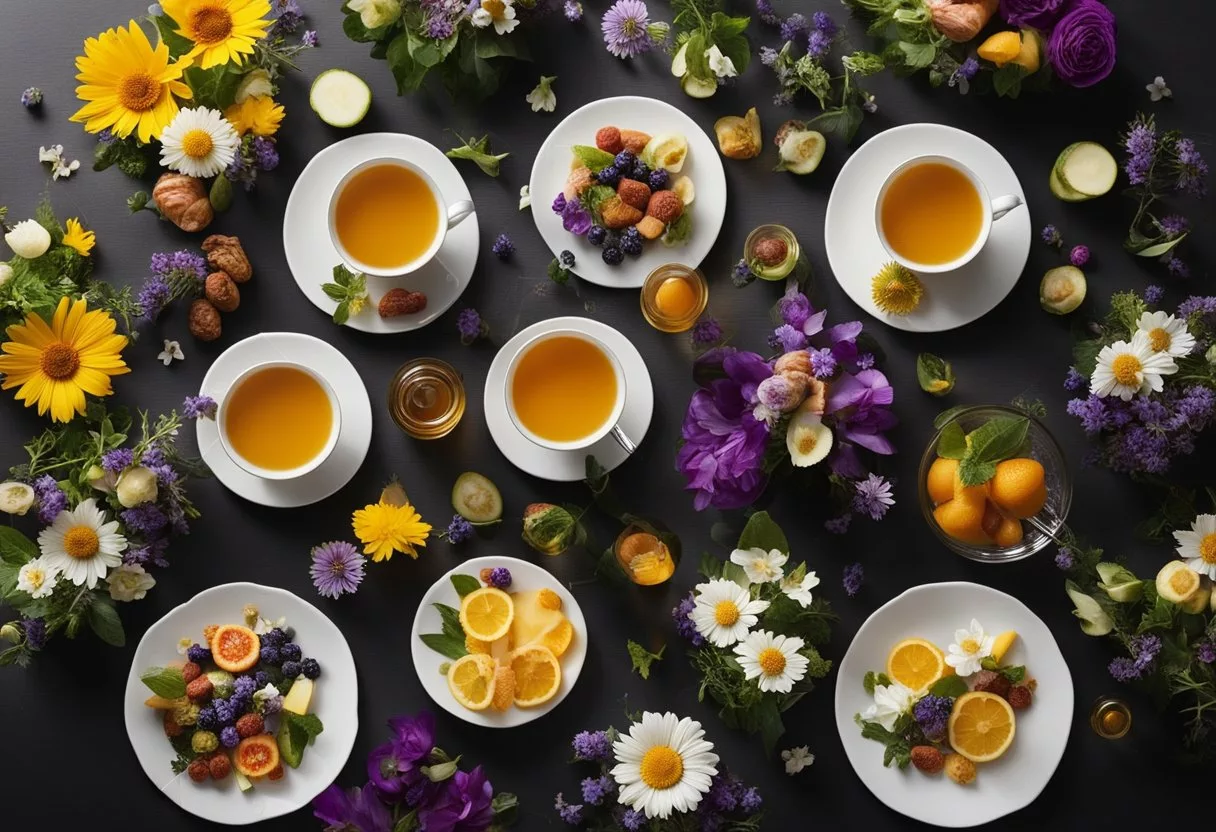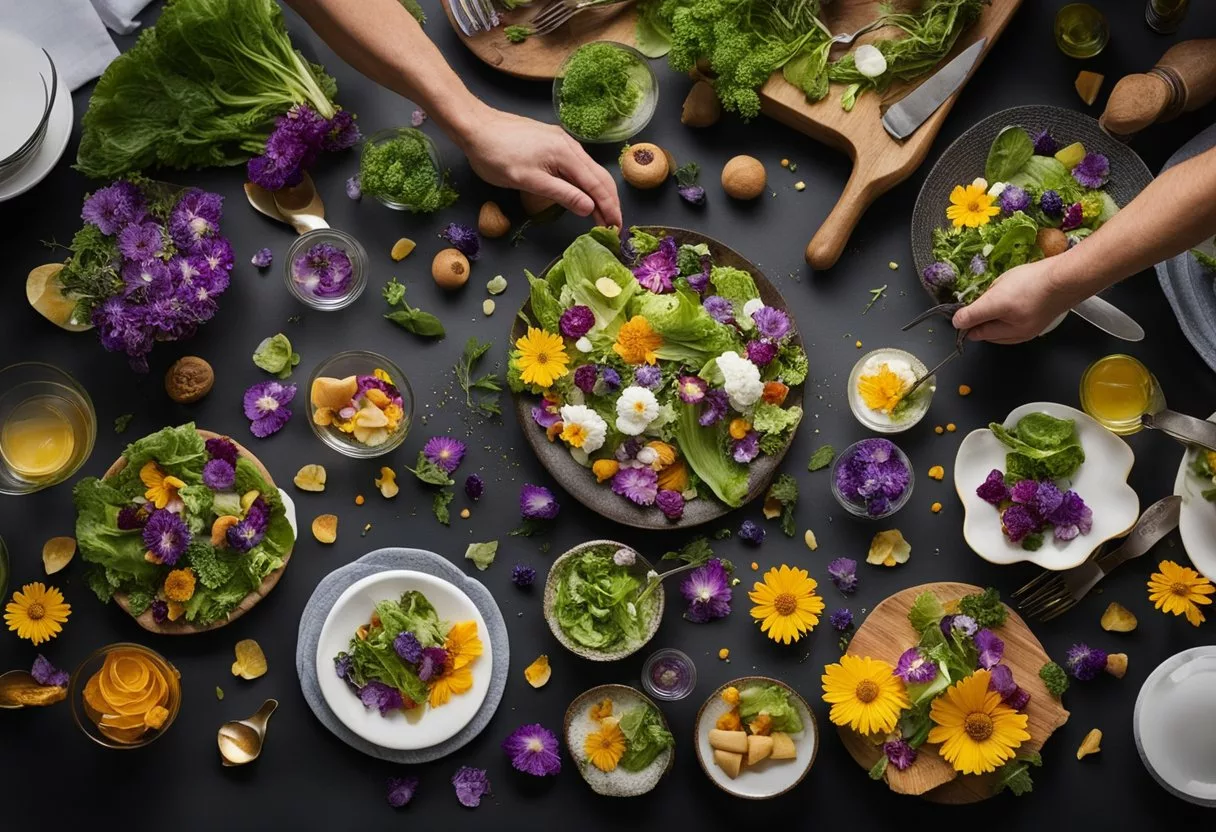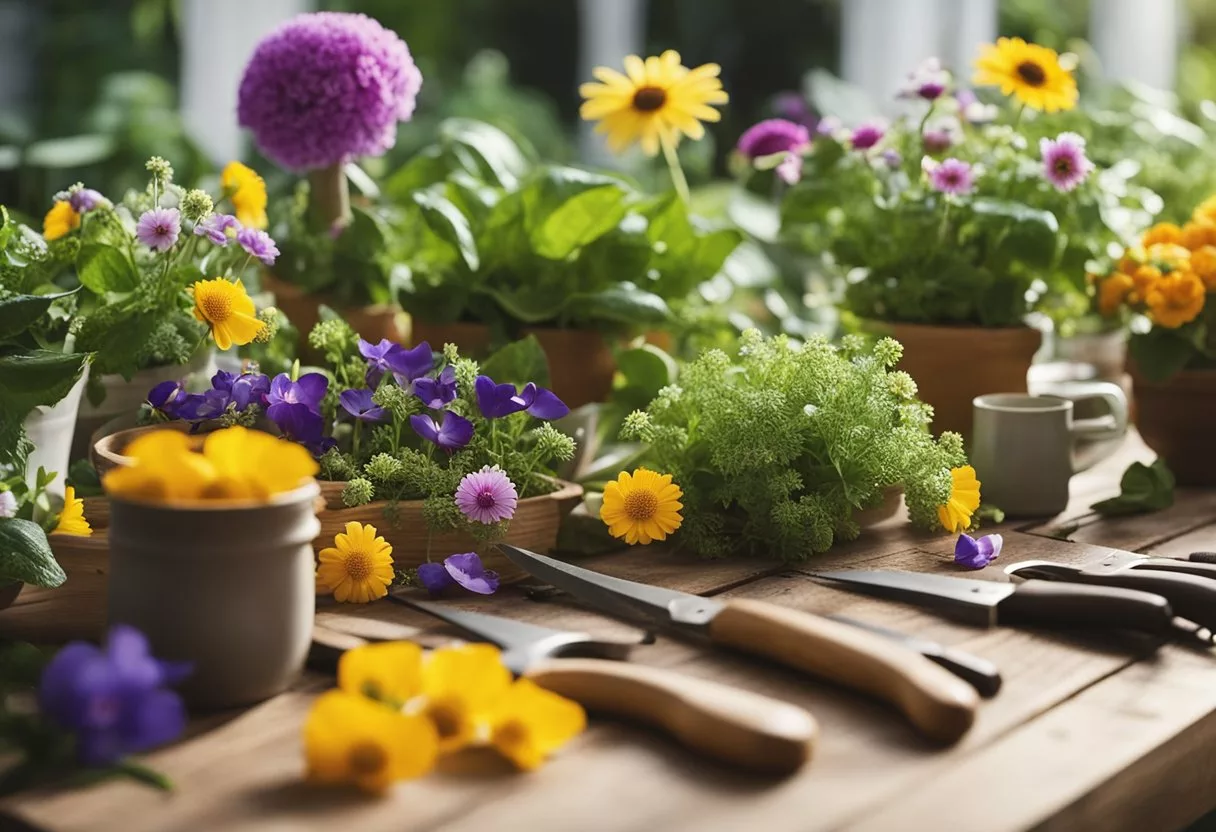Edible flowers add a unique flair to both dishes and drinks, making them a favorite among chefs and home cooks alike. They can be candied, used as toppings for cakes, or even incorporated into salads for a burst of color and flavor. From garden peas and green beans producing sweet blossoms ideal for decorations to daylilies that offer not just beauty but a delicious taste, there’s a flower for every palate.
Storing edible flowers correctly ensures they maintain their freshness and taste. For the best results, wrap them in damp paper towels and store them in a sealed plastic bag in the fridge. This simple step keeps them vibrant and ready to elevate any dish.
Whether you’re making a peppery oil from nasturtiums or exploring the versatility of dandelion blooms, incorporating edible flowers into your cooking doesn’t have to be complicated. With a little know-how, you can turn ordinary meals into extraordinary culinary experiences.
Key Takeaways
- Wrap edible flowers in damp paper towels and refrigerate for freshness.
- Edible flowers can be used in desserts, salads, and as garnishes.
- Many edible flowers add unique flavors and visual appeal to dishes.
Selecting Edible Flowers

Choosing the right edible flowers ensures both safety and flavor. Critical aspects include identifying safe flowers, growing them organically, and buying from reliable vendors.
Identifying Safe Flowers
Not all flowers are safe to eat. It’s essential to recognize which ones are edible. Flowers like pansies, nasturtiums, and violets are commonly used in cooking. Avoid flowers that have been treated with pesticides or come from unknown sources, as they may be toxic. Refer to reliable guides or consult experts in edible plants to confirm the safety of specific flowers.
Organic Gardening Practices
Growing edible flowers organically helps ensure they are free from harmful chemicals. Use organic soil, compost, and natural pest control methods. Companion planting, where different plants grow close together to deter pests, is an effective strategy. Regularly inspect the garden for pests and use organic solutions like neem oil or insecticidal soap to manage infestations.
Purchasing from Trusted Vendors
When buying edible flowers, it’s important to shop from reputable vendors. Look for sellers who specialize in organic or edible flowers. Check reviews and ask questions about their growing practices. Trusted vendors often provide detailed information about the flowers, including their origins and whether they are pesticide-free. Online stores and local farmers’ markets are good places to find high-quality edible flowers.
Preparation of Edible Flowers

Preparing edible flowers involves ensuring they are clean and storing them properly to maintain freshness. Follow these steps for optimal results in your culinary creations.
Cleaning and Storing Methods
To prepare edible flowers, first rinse them gently in cold water. This removes any dirt or insects. Be careful not to damage the delicate petals. Lay the flowers on a paper towel to dry. Lightly pat them dry if necessary.
For storage, wrap edible flowers in a damp paper towel to keep them hydrated. Place the wrapped flowers in a sealed plastic bag or container. Store them in the refrigerator. This method keeps the humidity high, preventing the flowers from wilting without soaking them in water.
Techniques for Preserving Freshness
One method to preserve freshness is to pick flowers as close to their use time as possible. This ensures they retain their vibrant color and taste. If you need to store them longer, consider using them in an infused vinegar or as a garnish.
Freezing is another option. Arrange clean flowers on a baking sheet and freeze them overnight. Transfer frozen flowers to an airtight container. They can be used directly from the freezer as garnishes.
Drying flowers is also effective for long-term storage. Remove the stems and place the flowers in a single layer on a drying rack or paper towel. Store dried flowers in an airtight container away from direct sunlight.
Incorporating Edible Flowers in Cooking
Using edible flowers in cooking can add unique flavors and beautiful visuals to your dishes. They can be used in everything from fresh salads to baked desserts, enhancing both the taste and the presentation.
Salads and Dressings
In salads, edible flowers like nasturtiums and pansies bring bright colors and peppery or sweet flavors. Marigolds and violets add a mild bitterness that balances well with greens.
For dressings, combine a few tablespoons of fresh flowers with olive oil, honey, and lime juice. Season with salt and pepper. This infusion elevates a simple salad with floral notes.
Edible flowers like garden peas and green beans can also be candied for a crunchy salad topping. Spray them with egg white, coat in superfine sugar, and dehydrate them to create beautiful, sweet accents for your greens.
Main Dishes and Sides
Flowers aren’t just for salads; they can enhance main dishes and sides, too. Zucchini flowers, also known as squash blossoms, work great in stuffed and fried dishes.
Add a mix of flowers such as rosemary blooms or chive blossoms to enhance the flavor of meats and vegetables. Infuse broths and sauces with these floral additions to create complex layers of flavor.
For example, marinate chicken or fish with a mix of edible flowers, olive oil, and herbs. This not only adds visual appeal but also imparts a subtle floral essence.
Desserts and Baking
Edible flowers are perfect for desserts and baking. Use roses, violets, and lavender to create both beauty and taste in cakes, cookies, and pastries.
Bake flowers directly into your recipes to infuse a subtle floral flavor. They can be mixed into batters or used as decorations on top. For instance, pavlova topped with fresh fruit and edible rose petals becomes a stunning dessert.
When making floral-infused desserts, ensure the flowers are safe to eat and have been properly washed. You can candy them for a longer shelf life and a decorative touch, using methods similar to those in salad toppings.
Beverages and Infusions

Edible flowers add unique flavors and vibrant colors to a variety of drinks. They can be used in everything from waters and teas to cocktails and syrups.
Flower-Infused Waters and Teas
Flower-infused waters and teas can be both refreshing and aromatic. To prepare floral water, you can use flowers such as rose, lavender, or hibiscus. Simply steep the petals in water for several hours. The water will take on a delicate flavor and a pleasing aroma.
For teas, flowers like chamomile, jasmine, and butterfly pea are popular choices. Chamomile tea has a soothing effect, while jasmine tea offers a sweet, floral taste. Butterfly pea tea changes color when you add lemon juice, creating a fun and visually appealing drink.
Cocktails and Syrups
Cocktails become more exciting with the addition of edible flowers. A rosella flower calyx can be dropped into champagne, gradually unfurling for a stunning effect. Dried hibiscus blooms can be steeped in rum for about 30 minutes for a vibrant, flavorful twist.
Edible flowers can also be used to make infused syrups. Lavender, elderflower, and rose petals are excellent for this. To make the syrup, boil water and sugar, then add the flowers and let it steep. Strain the mixture before using it in cocktails or as a sweetener in other beverages. This adds a subtle, floral touch that enhances the drink’s complexity.
Edible Flowers as Garnish

Using edible flowers as garnish can elevate the presentation of any dish. It involves careful placement and creative arrangements to make meals visually appealing.
Plating Techniques
When using edible flowers for garnishing, precision is key. Place flowers delicately on the edges of plates or sprinkle petals over dishes. Use tweezers for accuracy and to avoid handling the flowers too much.
For a fresh look, mix different colors and sizes. Small flowers like violets and pansies can add pops of color, while larger flowers like nasturtiums can be focal points. Remember to use flowers sparingly to avoid overwhelming the dish.
A simple way to start is by adding a small blossom on top of desserts or cocktails. This gives a touch of elegance without requiring much effort.
Edible Flower Arrangements
Creating flower arrangements for dishes can be both simple and effective. Start by choosing flowers that complement the flavors and colors of the food. Nasturtiums, for example, have a peppery taste that pairs well with salads.
Arrange flowers in clusters for a more dramatic effect. Use different shades and heights to create depth. For instance, a canapé with a cracker base can be topped with a spreadable cheese and a small cluster of blossoms like begonias or violas.
When arranging flowers on a cake, consider pressing them gently into the frosting. Align the flowers around the edges or create a central bouquet. This adds a beautiful and natural decoration that is entirely edible.
Health Considerations

Eating edible flowers is generally safe, but there are specific health considerations to keep in mind. These include potential allergic reactions and the various chemical properties of the flowers.
Allergy Information
People with allergies should be careful when consuming edible flowers. Pollen in some flowers can trigger allergic reactions. It’s important to start with small amounts to see if there are any adverse effects.
Some common edible flowers such as calendula and hibiscus might cause mild reactions in sensitive individuals. Eating these flowers should ideally be done after consulting with a healthcare provider, especially for those who have known allergies to plants or foods.
Purchasing flowers specifically grown for consumption is important. Flowers from florists or nurseries might contain pesticides, which can cause allergic reactions. When in doubt, it’s best to buy from reputable sources to minimize the risk.
Potential Chemical Properties
Edible flowers may contain chemicals that offer health benefits. Calendula, for example, contains flavonoids like linoleic acid that can support a healthy inflammation response. Hibiscus is rich in antioxidants, which can promote overall health.
However, some flowers can have toxic properties if not properly handled. Consuming flowers without proper identification can lead to ingestion of harmful substances. It’s crucial to ensure that the flowers are edible and free from pesticides or other chemicals.
Flowers like nasturtium and borage are not only safe but also nutritious. They can be used in a variety of dishes, adding flavor and health benefits. Using trusted information to identify and prepare edible flowers will ensure both safety and nutritional advantage.
Frequently Used Edible Flowers
Many edible flowers add unique flavors and colorful touches to dishes. This section covers popular varieties of edible flowers and their typical flavors, as well as seasonal flowers that are great for cooking.
Popular Varieties and Their Flavors
Nasturtiums have a peppery taste, often compared to watercress, and make a vibrant addition to salads and garnishes.
Calendula flowers, also known as pot marigold, have a slightly spicy, peppery flavor and can be used in soups and stews.
Borage flowers have a mild cucumber taste and are perfect for salads, lemonades, and cocktails.
Lavender is known for its sweet and slightly citrus flavor, often used in desserts, teas, and infused sugar.
Rose petals offer a sweet, slightly spicy flavor, ideal for jams, jellies, and syrups.
Chamomile has an apple-like taste, commonly used in teas and baked goods.
Elderflower is sweet with a floral taste, frequently used in cordials, syrups, and desserts.
Hibiscus blooms taste tangy and tart, great for teas, cocktails, and desserts.
Seasonal Flowers for Cooking
Lilac blooms, available in spring, provide a sweet, lemony flavor, perfect for syrups and desserts.
Chives produce edible flowers with a mild onion flavor, useful in salads, soups, and spreads.
Violet flowers, available in spring, offer a sweet, slightly minty taste, suitable for candies and beverages.
Pansies have a mild, slightly sweet flavor and are used in salads and cake decorations.
Marigold petals, often available in summer, are slightly tangy and can be used as a substitute for saffron or to add color to dishes.
Dianthus blooms, with a clove-like flavor, are great in desserts and infused beverages.
Growing Your Own Edible Flowers

Growing your own edible flowers can be a rewarding experience. This section covers how to get started and the best practices for caring for these plants.
Starting a Flower Garden
To begin growing edible flowers, choose a sunny spot in the garden with well-drained soil. Many edible flowers need 6-8 hours of sunlight daily. Marigolds, nasturtiums, and bee balm are some popular choices for beginners.
Soil preparation is key. Good soil is rich in organic matter. Add compost or aged manure to improve soil fertility. Follow by testing the soil pH, aiming for a range of 6.0-7.0, which is ideal for most edible flowers.
Planting seeds or seedlings is the next step. Direct sow seeds for flowers like nasturtiums and calendula, or transplant seedlings for more delicate varieties like lavender. Space plants properly, usually 6-12 inches apart, depending on the type, to ensure good air circulation and growth.
Caring for Edible Flower Plants
Once plants are established, consistent care is essential. Watering should be regular, especially in dry periods, but avoid over-watering. Early morning is the best time to water, reducing the risk of disease.
Fertilizing with a balanced, organic fertilizer can promote healthy growth and vibrant blooms. Apply according to the package instructions, usually every 4-6 weeks during the growing season.
Pest control is also important. Regularly inspect plants for pests like aphids or slugs. Use natural solutions such as neem oil or introduce beneficial insects like ladybugs to manage pest populations.
Pruning and deadheading (removing spent flowers) can encourage more blooms and prevent diseases. Additionally, certain edible flowers like bee balm will benefit from occasional division to maintain plant health and vigor.
For further information on edible flowers, including their flavors and uses, refer to Gardener’s Path on edible flowers.
Frequently Asked Questions

Edible flowers can add vibrant colors, unique flavors, and a touch of elegance to various dishes. Learn how to use them effectively and safely in your culinary creations.
What are the best practices for incorporating edible flowers into dishes?
To use edible flowers, rinse them gently under cold water to remove dirt and insects. Pat them dry with a paper towel. Add flowers to dishes right before serving to maintain their texture and color. For best results, start with a small amount and adjust based on taste and appearance.
In what ways can edible flowers enhance the flavor and presentation of baked goods?
Edible flowers can be candied or placed fresh on cakes, cookies, and other baked treats. Candying flowers involves coating them with egg white and superfine sugar to create a sparkly, sweet topping. This process makes them shelf-stable and adds a decorative, flavorful element.
Which edible flowers are most suitable for use as a garnish, and how should they be applied?
Popular edible flowers for garnishing include pansies, violas, nasturtiums, and marigolds. To garnish, place flowers gently on the dish right before serving. This keeps them fresh and vibrant. Ensure they are free from pesticides and washed properly.
How can you safely prepare and clean edible flowers before consumption?
Wash flowers thoroughly under cold water to remove any dirt or bugs. Use a damp paper towel to keep them fresh until needed. Keep flowers in a sealed plastic bag in the refrigerator for up to 14 days, ensuring they stay moist but not waterlogged.
Are there any considerations to be aware of when eating edible flowers raw?
When eating edible flowers raw, be cautious of allergies. Not all flowers are edible, so identify them correctly. Always use flowers grown without pesticides. If you’re unsure, consult a reliable guide or expert before consuming.
What techniques are used to adhere edible flowers to cakes for decorative purposes?
To adhere edible flowers to cakes, coat the flowers lightly with egg white using a small brush or fingertips. Dip them into superfine sugar and let dry for 24 hours. Press the flowers gently onto the frosting or icing, ensuring they stick firmly.